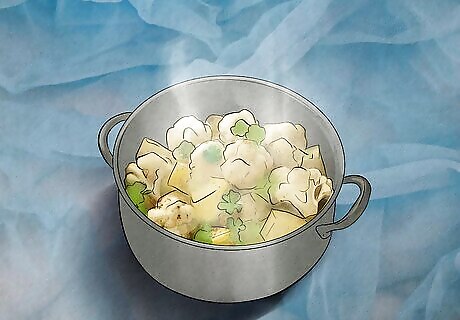
views
X
Trustworthy Source
Johns Hopkins Medicine
Official resource database of the world-leading Johns Hopkins Hospital
Go to source
It focuses on achieving balance between your body, mind, spirit, and environment.[2]
X
Trustworthy Source
Cleveland Clinic
Educational website from one of the world's leading hospitals
Go to source
Those who practice Ayurveda believe that an Ayurvedic cleanse, also called panchakarma, can help you achieve this balance. This cleanse involves following a specific diet for 3 to 21 days to detoxify your body. Read on as we explain what an Ayurvedic cleanse is and how to do one. Plus, we’ll take you through the risks and benefits to help you decide if it's right for you.
- An Ayurvedic cleanse aims to detoxify your body and promote physical, mental, and spiritual health. Start with a 3-day cleanse if this is your first time.
- It involves eliminating meat, dairy, alcohol, caffeine, sugar, and processed foods, while instead eating simple, warm foods, such as cooked vegetables and fruits and whole grains.
- Make time for self-care during the cleanse, including meditation and yoga, and reintroduce foods slowly once you finish the cleanse.
What is an Ayurvedic cleanse?

An Ayurvedic cleanse aims to detoxify your body and promote well-being. Originating in India 5,000 years ago, Ayurveda is one of the oldest medical systems in the world. Its goal is to achieve balance between the mind, body, and spirit through a specific diet and practices such as meditation and yoga. During an Ayurvedic cleanse, you’ll avoid certain foods, such as meat, dairy, refined sugars, processed foods, alcohol, and caffeine. Instead, you’ll focus on eating simple, warm foods, such as vegetable soups, cooked veggies and fruits, and whole grains.

An Ayurvedic cleanse typically has three stages. Each phase serves a specific purpose to ensure that your body gets the most out of your cleansing experience. Here’s a brief breakdown: Preparation/Pre-Cleanse Phase: Involves slowly adjusting your diet and lifestyle to prepare your body for the cleansing process. You’ll start eliminating meat, dairy products, added sugars, caffeine, alcohol, and processed foods. Active Cleanse/Kitchari Phase: The main cleansing period. Your diet will consist primarily of variations of Kitchari, a traditional Ayurvedic dish, as well as certain other foods like Ghee and spices. Reintroduction/Rejuvenation Phase: Essentially involves returning to stage one. You’ll gradually reintroduce a wider variety of foods, while also focusing on hydration to rejuvenate your body.
Choosing the Length of Your Cleanse

Most Ayurvedic cleanses last 3 to 21 days. A complete traditional Ayurvedic cleanse, also called Panchakarma, takes 21 days, but you can absolutely detox for shorter periods of time depending on your schedule and preference. If this is your first cleanse, you may want to start with 3 days. Just be sure to allot an equal number of days to each of the 3 stages to feel their full effects. For example: 3 Day Cleanse: 1 day of preparation, 1 day of active cleansing, 1 day of reintroduction 9 Day Cleanse: 3 days of preparation, 3 days of cleansing, 3 days of reintroduction Full 21 Day Cleanse: 7 days of preparation, 7 days of cleansing, 7 days of reintroduction
Preparation

Cut back on processed foods to prepare your body. For up to a week before officially starting your detox, cut back on the foods and beverages you’ll fully eliminate when the cleanse starts. These include sugar, processed foods and flours, meat, fish, dairy, cold or raw foods, fried foods, alcohol, and caffeine. Staying hydrated is also important during this period, so drink plenty of water! For a 3-day cleanse, do at least 1 day of preparation. For a 9-day cleanse, do 3 days of preparation. For a full 21-day cleanse, do 7 days of preparation.

Add warm, simple foods to your diet. Warm whole foods are thought to balance your digestive fire, or agni. These include cooked vegetables and fruits, whole grains, spices, and seeds. Here are some examples of foods to eat during this period: Roasted or sautéed veggies (broccoli, cauliflower, brussels sprouts, carrots, zucchini, asparagus, cabbage, spinach, etc.) Light, dairy-free vegetable or lentil soups Whole grains like basmati rice, quinoa, and oats Spices like cumin, coriander, and ginger Flaxseeds, sunflower seeds, pumpkin seeds, and sesame seeds Cooked or poached fruits (apricots, apples, pears, prunes, berries, and figs) Herbal teas Ghee, a type of clarified butter, is also an important part of an Ayurvedic diet. It’s thought to promote “oleation,” or the process of introducing healthy oils into the digestive tract to help eliminate toxins.
Active Cleansing

Eat kitchari during your cleanse. Kitchari is a traditional Indian dish that combines whole grains, legumes, and spices in a warm, flavorful soup. It typically includes rice and mung beans or lentils, along with spices, veggies or fruits, and ghee. There are many different kitchari recipes, from sweet breakfast options with cinnamon and nutmeg, to savory recipes for dinner time. To start, try eating kitchari for lunch and dinner. For breakfast, eat a simple, warm meal made from the list of approved foods, such as oatmeal and fruit. If you feel comfortable, gradually work towards eating kitchari for all 3 meals each day. Continue following this diet for the duration of your active cleansing phase.

Cleanse for 3-21 days. Let your body and mind guide you when determining how long to do an Ayurvedic cleanse. If you're just starting out, 1-3 days might work well. As you get more familiar and comfortable with Ayurvedic cleanses, you could work up to 21 days. For a 3-day cleanse, do 1 day of active cleansing. For a 9-day cleanse, do 3 days of active cleansing. For a full 21-day cleanse, do 7 days of active cleansing.

Focus on your emotional and spiritual well-being. Practice mindfulness, which involves being intensely aware of what you’re feeling in the present moment. Mindfulness includes practices like meditation and yoga, and it can help lower anxiety and stress levels. Reduce your use of electronic devices, and instead focus on self-care and self-reflection. Journal about your feelings, spend time hiking in nature, or read an uplifting book—whatever brings you the most joy and makes you feel the most connected to your spiritual side!
Reintroduction

The final phase of an Ayurvedic cleanse is a return to the first phase. Instead of eating only kitchari, gradually return to eating a larger variety of foods, while also focusing on hydration. Slowly reintroduce meat, dairy, and sugar, paying attention to how your body feels as you do this. You may find that you crave these foods less after participating in the cleanse! For a 3-day cleanse, do at least 1 day of reintroduction. For a 9-day cleanse, do 3 days of reintroduction. For a full 21-day cleanse, do 7 days of reintroduction.
Benefits & Risks of Ayurvedic Cleanses

Benefits: Ayurvedic cleanses can have positive health effects. Ayurveda hasn’t been thoroughly studied in scientific research, but those who practice it believe in its positive effects on physical and mental health, as well as spiritual well-being. For example, the elimination of processed foods and the focus on whole grains, fruits, and veggies during a cleanse can help you manage your weight. Additionally, reducing your alcohol intake can lower your blood pressure and cholesterol, promote a healthy weight, and lower your risk of stroke and certain cancers.

Risks: Ayurvedic cleanses require you to cut out food groups. Some of these foods, such as meat, fish, and dairy, can be part of a balanced, healthy diet. If you’re someone who typically struggles to get enough nutrients, an Ayurvedic cleanse may be too restrictive for you. Avoid doing an Ayurvedic cleanse (or any type of restrictive detox diet) if you’re pregnant or have an eating disorder. If you’re experiencing any unexplained symptoms or health problems, see a healthcare provider to get to the root of the problem before trying an Ayurvedic cleanse. If you’re a healthy adult interested in Ayurveda, a cleanse may be right for you, but be sure to inform your healthcare provider, so they can help ensure your safety.
Ayurvedic Recipes

Basic kitchari recipe: Start by rinsing 1 cup of uncooked mung beans until the water runs clear, then place them in a pot with 4 cups of water and bring it to a boil. Turn off the heat and allow the beans to rest for 1-2 hours in the water, then drain and rinse. Add 1 tablespoon of ghee or sesame oil to a large pot over low heat. Next, add in 1 teaspoon of ginger powder, 1 teaspoon of black mustard seeds, 1 teaspoon of cumin, 1 teaspoon of turmeric powder, and ½ teaspoon of salt. Heat the mixture for a few minutes while stirring. Add in the mung beans and ½ cup uncooked basmati rice and continue to stir. Next, add in 6 cups of water and increase the heat. Bring to a boil for 10 minutes. Reduce heat to low and cover the pot, then cook for an additional 30-40 minutes, or until the mung beans and rice become soft.

Breakfast kitchari recipe: Soak ¾ cup of mung beans and ¾ cup of brown basmati rice overnight. In the morning, drain the beans and rice. In a pot over medium heat, warm 2 tablespoons of coconut oil until melted. Add in ½ teaspoon of ground cinnamon, ¼ teaspoon of ground ginger, ¼ teaspoon of ground cardamom, and 2 cloves. Cook for about 1 minute. Add in the mung beans and rice and stir, then add in 4 cups of water and bring to a boil. Reduce the heat to a simmer and cover the pot. Cook for 15-20 minutes until the water is absorbed. Remove from the heat and stir in ¼ cup of coconut milk. Drizzle honey on top to sweeten. Feel free to top with fruits of your choice, such as poached apples or pears, or fresh berries!

Ayurvedic Cauliflower and Potato Recipe: Gather 4 cups of cauliflower and potato and one medium tomato. Chop all the veggies into bite-sized pieces. Peel and finely dice 1 ½ inch piece of fresh ginger, and place into a blender. Add 2 tablespoons of unsweetened shredded coconut, ¼ cup of chopped fresh cilantro, and ½ cup of water into the blender. Blend until smooth and set aside. Heat 3 tablespoons of safflower oil in a pan, and add in ½ teaspoon of cumin seeds and 1 teaspoon of black mustard seeds, and then stir. Add your blended mixture to the pan, along with ½ teaspoon of masala powder, ¼ teaspoon of turmeric, and ¼ teaspoon of salt. Next, add in the cauliflower, potato, and tomato and stir. Pour in 4 cups of water, then cover and cook until the veggies are slightly soft.

Ginger Tea Recipe: Add one heaping teaspoon of coarsely chopped, unpeeled ginger into a cup of hot water. Steep the tea for 2 minutes, then strain out the ginger. Flavor your tea with organic honey, fresh chopped mint leaves, or sliced lemon.




















Comments
0 comment